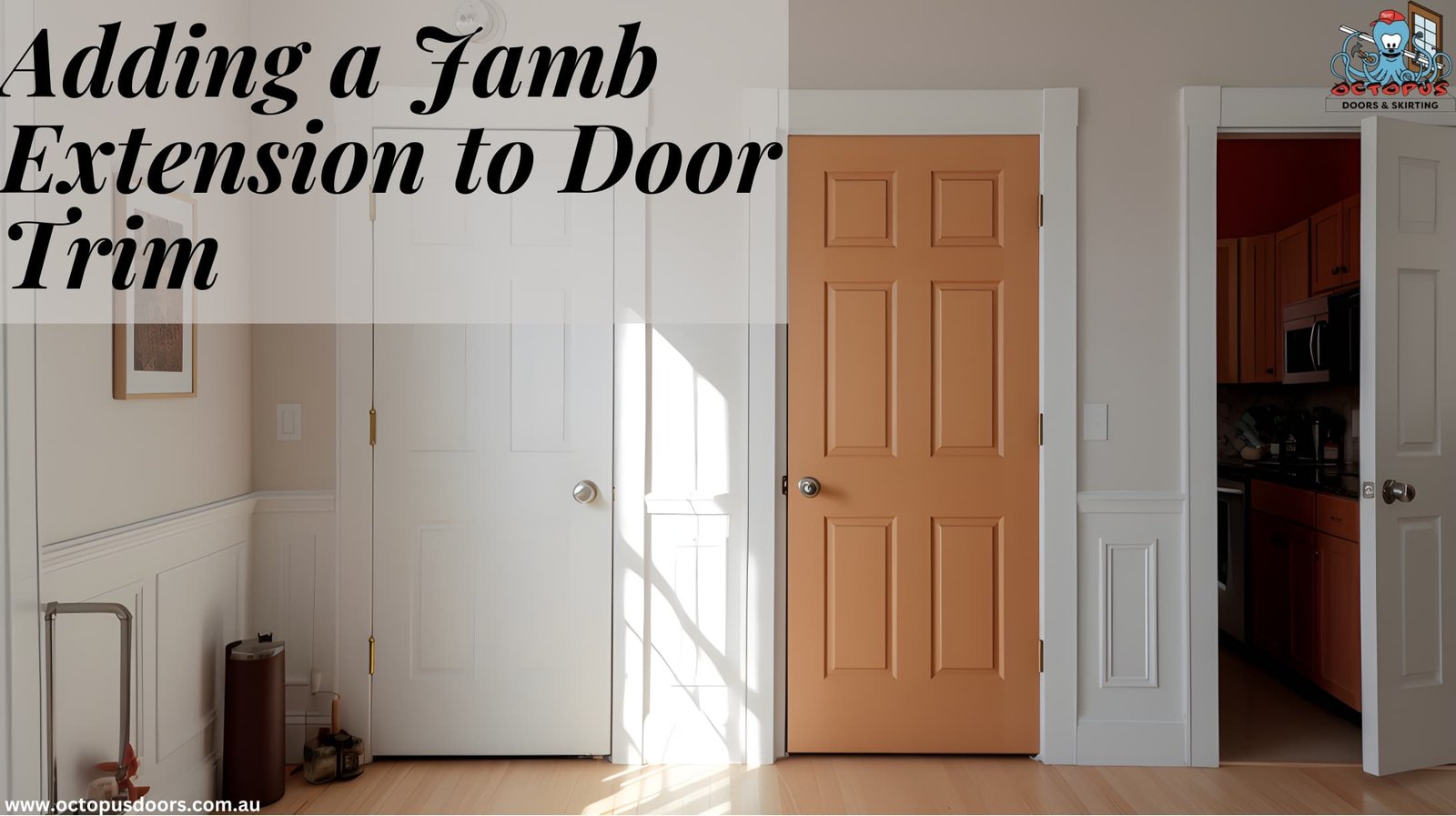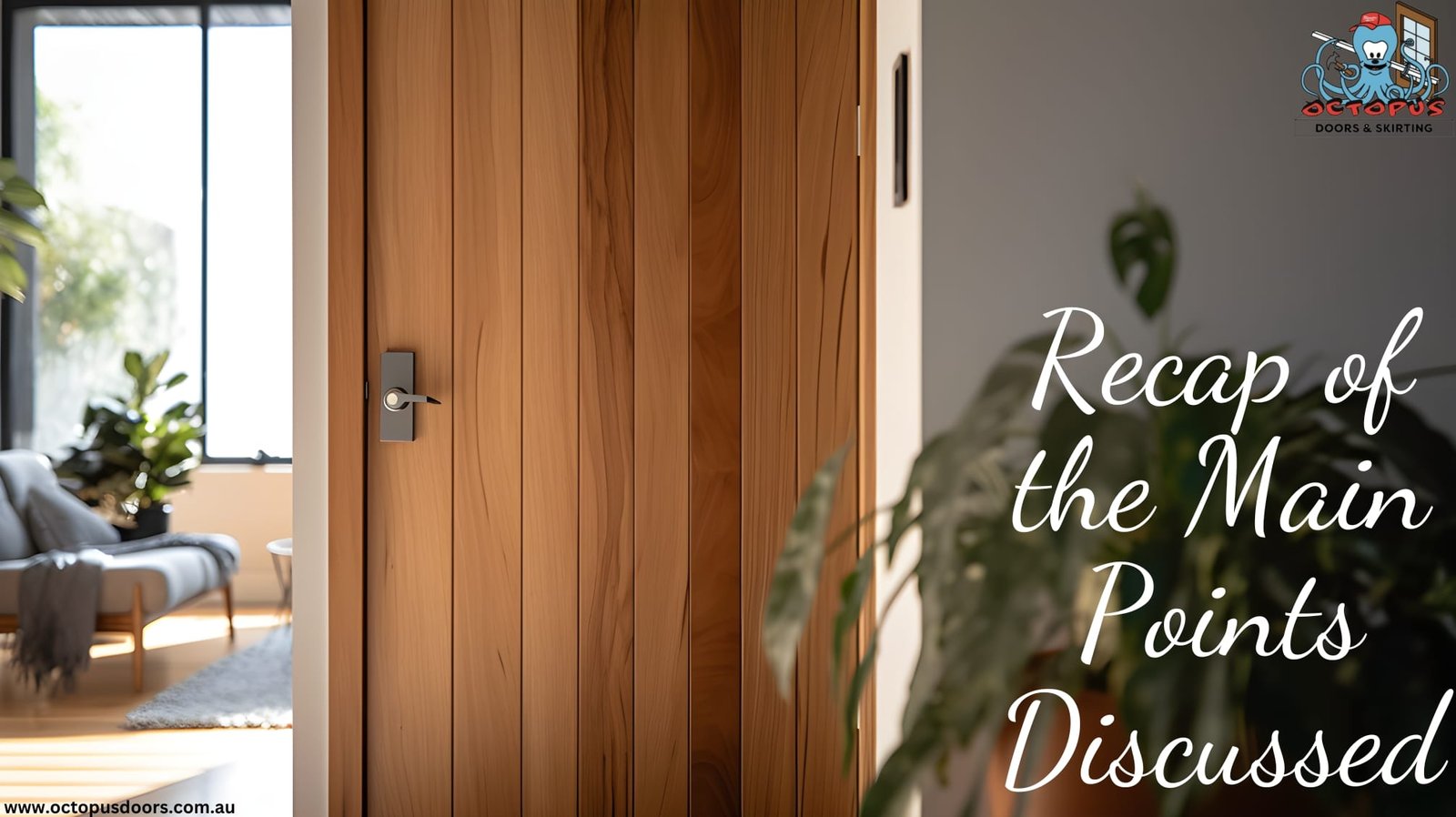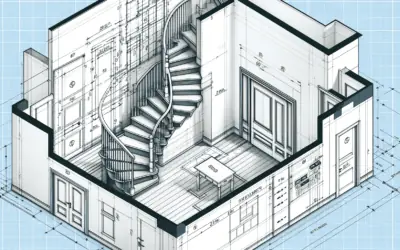
Do your doors not fit in your walls properly? You’re not alone. This comprehensive guide will help you tackle the problem – from adjusting the door to making trim adjustments. Get ready to learn how to handle doors too close to walls for a trim!
Common scenarios where this problem occurs
Many homes and apartments face various spatial constraints that affect door placement. These problems arise due to narrow hallways, cramped apartments, corner doors, and the proximity of walls to the door opening. It becomes challenging to maintain an elegant interior design while managing space with these architectural flaws.
A table can help understand the common problems with door installation concerning wall proximity and space management. To begin with, determining how close a door can be to a corner is essential. Based on building regulations for door placement, the minimum distance of a door from a wall depends on the size of the opening leaf. However, it becomes challenging to maintain this standard due to space constraints. The table below lists some scenarios that commonly occur when dealing with small spaces:
| Problem | Scenario |
|---|---|
| Door contacting wall | Narrow hallway |
| No or limited trim | Cramped apartment |
| Inadequate frame depth or too much frame depth | Corner doors |
| Insufficient room for the opening arc | Room design |
Aside from these common problems, numerous unique details are associated with solving this problem specific to different designs and space restrictions.
It is worth noting that compliance with construction standards and building codes is critical when resolving door placement issues in architectural design and home improvement projects.
In summary, addressing doors too close to walls requires thoughtful consideration of various factors beyond simple construction standards. With attention to detail and creative solutions, homeowners can efficiently manage their limited space without sacrificing elegance or functionality.
According to “Building Code Requirements for Windows and Doors,” published by the American Architectural Manufacturers Association. It looks like it’s time to bust out the measuring tape and channel our inner carpenter because eye-balling it just won’t cut it.
How to Measure the Gap
Measuring the Width of Door Gaps for Trim
Proper measurement techniques and tools should be employed to ensure accuracy when assessing the distance between a door and a wall. Here is how to measure the gap.
- Get a tape measure or ruler: These measuring tools can be used to determine the distance between the door frame and the wall edge.
- Check the size of your door trim: Door trim often covers part of the wall’s interior surface, making it necessary to check the sizes.
- Use callipers if necessary: If your gap appears too small for measurement with a ruler or tape measure, callipers may work best.
- Assess space precisely: While taking measurements, it is important to evaluate all aspects of space and not just one point.
- Measure using different points on both sides: To understand whether there is any variance between distances on opposite sides of a door opening, measuring both sides can prove beneficial.
- Confirm gap dimensions prior to installation: Before deciding where the door hardware will go or ordering new materials, confirming accurate measurements before finishing adornment or furniture assembly is recommended.
You must employ good measuring techniques so that gaps are accurately assessed before any installations occur.
In addition to these basic instructions, carefully evaluating situations unique to your specific construction project or DIY home renovation effort will support improved quality in workmanship.
Pro Tip:
When considering installing new trim or other hardware following the calculation of your gaps, wait until every surface has been painted before proceeding with final touches associated with beautification efforts on either side of the affected adjacent corners that adversely affect precision gains due to paint thickness near edges.
Extend the love to your door trim with a jamb extension – because who doesn’t love a little extra length?

Adding a Jamb Extension to Door Trim
Door Trim Enhancement: The Complete Guide to Adding a Jamb Extension
Adding a jamb extension to the door trim involves modifying the door jamb by mounting an extension piece to increase its size. This technique is known as a jamb augmentation and is commonly used to increase door jamb depth or extend the trim away from the wall.
Here are the steps for installing a jamb extension kit:
- Remove the existing trim – Use a pry bar to remove all existing trim around the door, including casing and baseboards, if necessary.
- Measure accurately – Use precision tools to measure the exact dimensions of the door frame, including height, width and depth.
- Prepare the extension pieces – Cut your extension pieces using carpentry tools according to your measurements. Sand them down and prime them before you begin the installation.
- Attach the extensions – Mount your new extensions onto their respective sides of the door using glue and screws or nails.
For more advanced techniques for extending door jambs using different types of materials such as MDF, visit expert home renovation websites or contact a carpenter who can assist with door jamb augmentation.
When installing your new jamb extensions, finish with any additional door trim enhancement work required, such as sanding and painting. Finally, admire your brand-new upgraded doors!
Don’t miss out on enhancing your home with these simple modification techniques! Add another layer of finesse by upgrading your doors with this method today!
Are you cutting the baseboard? More like cutting your patience in half.
Cutting the Baseboard
Achieving precision trimming is crucial when handling baseboards too close to walls for trim. Proper baseboard adjustment techniques are required to avoid damaging the wall or trim and to create a sleek and seamless finish. The process of trimming baseboards that are too close to walls involves several steps, with cutting being one of them.
- Measure the distance between the baseboard and the wall where you will make the cut.
- Mitre saws are ideal for making straight cuts, while a coping saw works well for corner cuts. Choose the tool according to your needs.
- Use a utility knife to mark the spot where you will make the cut. Score along this line before proceeding with the cutting.
- Place the baseboard in the mitre saw at a 45-degree angle to create a mitre cut. Then, carefully make your cut following your score.
- Coping cuts require more skill and precision but can provide seamless corner joints. Use a coping saw to achieve this type of cut by following the lines tightly without applying too much pressure on the blade.
When adjusting your baseboard trims, do not apply excessive force, as it can damage both the trim and walls. Additionally, ensure you have measured precisely before making any modifications to your baseboard trim.
Story Time: A DIY enthusiast was working on an old house’s renovation project and needed precise cuts around corners using their trusty coping saw. Still, they found that handling angled cuts required considerable attention and patience. After many tries, they realized that holding their tool correctly aided their precision work without breaking blades unnecessarily. As such, they were able to complete their task and attain professional finish trimming.
Making 3/4 Rips: When life gives you a door that’s too wide for its frame, rip it.
Making 3/4 Rips
Efficiently cutting 3/4 strips from a wood piece is crucial in precision woodworking. This technique is called ‘ripping wood strips’ or ‘cutting 3/4 strips’.
- Align the table saw with the wood piece, keeping it at an appropriate length so that the portion to be ripped lies on one side of the blade, keeping the motor on the other.
- Set the cutting blade to the required height and affix safety gear, such as safety goggles and gloves.
- Place the wood strip onto the table saw surface, ensuring that it contacts both the rip fence and blade, respectively.
- Push the wood strip steadily through saw teeth, holding it firmly against the rip fence while maintaining continuous movement. Repeat steps meticulously until desired measurements are achieved.
It is essential to ensure several safety measures when making custom cuts using a table saw for 3/4 rips, like affixing top-quality safety gear such as gloves and goggles.
It is vital to understand the nuances of precise cuts while engaging in DIY carpentry or woodworking projects. To avoid accidents, using a circular saw instead of a table saw can also be considered while making customized patterns depending on your comfort level.
To grow as an expert in woodworking, tap into the wisdom provided by the tips mentioned here.
Who needs a partner when you have a combination square to ensure your door and trim have a perfect match?
Using a Combination of Square
Achieving precision measurement is crucial in carpentry, woodworking and DIY home renovation. A combination square is an accuracy tool that has several uses in carpentry. It is a multipurpose tool that includes a steel rule, scriber, centre finder and 90-degree angle head. Using a combination square accurately will enhance quality and precise results in woodworking projects.
In order to use a combination square effectively, you should follow these six steps:
- Choose the side of the ruler with more vibrant markings and place it alongside the workpiece
- Place the 90-degree angle against the edge of the piece while pressing it tightly against the material
- Use the centre finder to check if there are any irregularities on all four sides of the material and make sure that they are equal to each other
- Mark using a scriber or pencil to indicate your desired cut line
- Align your saw blade or cutting edge perpendicularly to your mark, then carry out your cut
- Finally, check for accuracy by placing it against direct edges such as corners or squared material
It is important to note that while using a combination square can be extremely helpful in carpentry works, its benefits extend to various other sectors like DIY home renovation projects.
One significant history regarding this essential tool was invented by Laroy S Starrett, a young machinist from Athol, Massachusetts, who devised a new and innovative way of manufacturing accurate squares in 1880. He created a prototype that was not only practical but elegant too and went ahead to establish The L.S. Starrett company, which now produces various other kinds of measuring tools, including combination squares.
You thought installing the third piece would be easy until you realized it’s like trying to fit a square peg into a round hole but with doors and walls.

Installing the Third Piece
The Final Assembly
Here, we delve into the process of attaching the final trim piece to the door, also known as the third piece. This critical stage determines the success of your overall door installation process.
- Load a nail gun with finishing nails and carefully tack on the third piece to the top jamb. Use care not to damage or split the wood.
- Utilize wood glue or adhesive on relevant areas for added firmness and longevity.
- Center the third piece over the side casing and carefully align it at a right angle with adequate spacing remaining between it and any other wall features like outlet plugs or switches.
- Nail in its place along its length while ensuring no nails penetrate from inside or outside of its boundaries.
- If necessary, wipe off any excess adhesive sticking out from beneath your new third-piece instalment slightly.
- The final step involves installing trim attachments over any wood milling machines that may still be sadly visible to conceal them seamlessly underneath your door trim section.
It’s worth noting that caring attention is integral to this part of completing your door installation. Neglectful instalments could seriously compromise your home renovation project’s outcome by detracting from its aesthetic value.
Consider following our complete carpentry techniques guidebook for more comprehensive guidance on installing and maintaining carpentry fixtures like doors.
Finally, according to professional carpenters interviewed for this article, glue joints will always dry harder than surrounding surfaces when settling; this fact implies that if not applied correctly, glue can negatively impact parts of your home improvement projects like installation/woodworking crafts leading to sub-par results.
If sanding and rounding over the edges were an Olympic sport, I’d definitely take home the gold medal in door trimming.
Sanding and Rounding Over the Edges
Refining and Smoothing Wood Edges
When dealing with doors too close to walls for trim, you may find achieving a smooth wood finish challenging. One way to solve this problem is by sanding and rounding over the edges of the wood. This process enables you to create a seamless edge that seamlessly blends with the existing wall.
Follow these 5 simple steps in edge smoothing:
- Choose appropriate sandpaper or electric sander.
- Begin the sanding process along with the grain direction.
- Use wood file for corners for precise shaping of edges.
- Start process refinements with finer-grit sandpaper for a smooth surface.
- Smooth wood edges further by rounding up with light strokes of fine-grit sandpapers or sponges.
To prevent sawdust build-up during the sanding process, periodically check your tools’ dust collection bag and empty it as needed.
To ensure effective edge-rounding, keep an eye on your woodworking project’s details like angles and profiles, among other things.
It is essential to master these unique tips on how to sand and round over wood, especially if you’re working on DIY carpentry projects at home.
Fun Fact: Woodworkers have used various abrasive instruments since ancient times, such as bronze scrapers, but often used ultrafine shark skin instead of standard abrasive materials.
If all else fails, embrace your inner bull in a china shop and smash through the wall instead.
Alternative Solutions
For More Possible Options
Consider these other viable alternatives for dealing with doors that are too close to walls and require special solutions for trim. Each option might better fit you, depending on your home’s layout, door placement, wall structure, or plan B.
| Construction Solutions | Pros | Cons |
|---|---|---|
| Relocating Door | Better Appearances | Time-consuming |
| Modifying Wall | Will Maintain Building Structure | Could damage interior aesthetics |
| Custom Trim | Aesthetic Appeal | Expensive |
It may also be useful to explore the option of different approaches to home renovation or building modification if neither relocation nor modifying walls prove viable.
Pro Tip: Getting creative with door placement can open up other possibilities for handling doors near walls and avoiding standard trim options. Get ready to tackle those pesky doors that never seem to fit with this comprehensive guide – no more awkwardly shuffling through a sliver of space!

Recap of the Main Points Discussed
Here, we discussed door trim techniques when doors are too close to walls. Here is a quick review of the key takeaways to help you install your door trim perfectly:
- First and foremost, measuring your space correctly is crucial in ensuring a seamless installation.
- When cutting your trim, do so at a 45-degree angle to make room for the door handle.
- Using alternative solutions, such as flexible or tapered trim, can also help with tight spaces.
- In addition to trimming around your door frame, installing plinth blocks and rosettes can add an elegant touch to your décor.
- Finally, proper sanding and caulking ensure a polished finish.
Remembering these main points when tackling installations like this one is important. Additionally, keep in mind that subtle nuances like different wall textures or differing paint colours can change how even a tiny gap appears.
A true story I encountered was when I helped my friend with his home renovation. He had installed his own trim but had not measured correctly and ended up with gaping holes where there should have been seamless coverage. Through our combined efforts and some creative solutions, we corrected the errors and ensured the rest of his project was perfect.
Remember, the only thing worse than doors too close to walls is not getting invited to the housewarming party in the first place.
Final Thoughts and Advice
With the installation of door trims in close proximity to the walls, it’s crucial to ensure that you handle the process effectively. Our expert insight recommends taking necessary safety precautions during the DIY process to prevent any injuries. As part of our final advice for door trim installation, make sure you’re equipped with the right tools and materials before starting work.
Additionally, it’s important to consider aesthetic considerations when deciding on door trim placement. Professional recommendations suggest positioning door trims to align with adjacent walls seamlessly. When faced with doors too close to walls, expert tips suggest installing the trims flush against them.
Lastly, remember to consider efficient practices while dealing with doors too close to walls. Some experts recommend using multi-functional tools that can cut corners accurately. Parting words for readers engaging in home renovation projects is not to compromise on quality while selecting materials for your DIY project.
As a true fact from BobVila.com, “Trim can transform a space from basic and boring into ornate and elegant.”
Frequently Asked Questions
What is the recommended distance between a door and a wall when installing trim?
The recommended distance is at least 1/8 inch to ensure the door can open and close smoothly without rubbing against the trim or wall.
What should I do if my door is too close to the wall for a trim?
Depending on the space between the door and the wall, several solutions exist, including using a thinner trim or a router to create a relief cut in the trim to fit around the door.
Can I install the trim first and then the door?
It is not recommended as it can cause damage to the trim during door installation. It is best to install the door first and then add the trim.
Is it necessary to use nails to secure the trim to the door frame?
While it is possible to use adhesive instead of nails, it is recommended to use both for a strong and secure installation.
Can I paint the trim before installation?
Painting the trim before installation can make the process easier and save time. Make sure to touch up any areas that may be damaged during installation.
What kind of saw should I use to cut the trim?
A mitre saw is the best tool for cutting trim, allowing for angled cuts and precision measurements.
Related Articles:
Defying Decay: The Surprising Truth About Steel Doors and Rust
Rust formation is a prime concern for any steel product exposed to the elements. As a naturally corrosive metal, steel reacts when it comes into contact with oxygen and moisture, leading to oxidation and the development of the distinctive reddish-brown rust. Rust...
One Key to Rule Them All: The Locksmith’s Guide to Universal Access
A single key that opens every door in your home or office can make life more convenient. But can a locksmith configure such a master key system? What are the benefits and potential downsides of keying all locks? In this comprehensive guide, we'll explore the ins and...
What Type of Door is Best for a Bathroom?
Choosing the right door is one of the most important design decisions when renovating or building a new bathroom. The bathroom door must balance style, functionality, privacy, and space efficiency. Selecting the optimal door type and material requires careful...
The Great Debate: Are There More Doors or Wheels in the World?
Whether there are more doors or wheels in the world has recently sparked lively debate and curiosity worldwide. It seems trivial, but the discussion reveals intriguing details about infrastructure, manufacturing, culture, and our lives. Opinions are split on the...
Exploring Unconventional Spaces: Can You Have a Basement Without a Door?
Key Takeaways Basements can exist without doors, but for safety and accessibility reasons, it's not advised. Reasons for a doorless basement might include ongoing remodelling or use as a storage area where regular access is not required. In the absence of a door,...
Are Glass Doors Required on Gas Fireplaces?
Gas fireplaces are popular for homeowners looking to add warmth and ambience to their living spaces. But when it comes to safely and efficiently operating these fireplaces, many wonder whether glass doors are a necessary component or simply an attractive add-on. This...
Innovative Trim Alternatives: Using a Door Stop Instead of Quarter Round
Do you have unsightly gaps between your flooring and baseboards that need covering up? Installing quarter-round moulding is a standard solution, but door stops provide a simpler and more affordable alternative. Quarter-round moulding is frequently used to cover the...
Door Facts: A Historic and Cultural Journey Through the World of Doors
Doors are such a ubiquitous part of our everyday lives that it's easy to overlook their rich history and cultural significance. Yet behind every door lies a fascinating story waiting to be discovered. This article takes you on an enlightening tour through the world of...
Home Master Hardware Door Hinges Review
Upgrade your residential interior doors with Home Master Hardware Door Hinges. Durable, rust-resistant, and easy to install. Smooth and quiet operation. Versatile for various settings. Get yours now!
6-Pack Door Hinge Review
Upgrade your door hinges with the 6-Pack Black Heavy Duty Door Hinge. Made with high-quality stainless steel, it offers strength and durability. With its smooth operation and 3mm thickness, it’s perfect for commercial and residential doors. Meet ANSI/BHMA standards and includes 48 screws.
Maximizing Space with Style: The Pros and Cons of Installing a Pocket Door at the Top of the Stairs
Having a door at the top of a staircase can provide privacy, soundproofing, and safety for your home. But is it possible to install a space-saving pocket door in this location? In this comprehensive guide, we'll dive into everything you need to know about installing a...
Solving the Mystery: Why is My Ring Doorbell Ringing When No One is There?
Key Takeaways: Facts and Statistics According to a Ring survey, 30% of Ring doorbell users have experienced their doorbell ringing when no one is there. Ring doorbells use passive infrared (PIR) sensors to detect motion, which various external factors can...
Message Us
Get In touch below. Ask Any Question or Start a Free Quote
Call Us
1800 491 492
I'm James Davis, a carpenter with eight years of experience in carpentry services, repairs, installations, renovations, and maintenance of interior doors. I have a diploma in carpentry and joiner trade from the Education Skills Australia Institute and take pride in delivering high-quality results to ensure customer satisfaction. I'm a blog writer for Octopus Doors Company and enjoy sharing my knowledge and tips on maintaining security measures and choosing the right door materials, paints, or handle styles. I specialize in custom-made interior doors and strive to make every home look fabulous. Contact me anytime for help with door-related issues.












